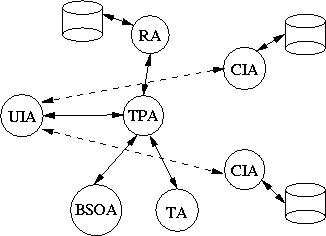


Next: Task Planner Agent
Up: Task Planning Agents in
Previous: Introduction

A fundamental activity in the University of Michigan Digital Library
(UMDL) is connecting people/agents that need help accomplishing their
tasks with people/agents that are capable of doing those tasks. A
canonical example is that of a library user in search of information
who needs to contact the appropriate collections which contain the
information. The job of a task planning agent (TPA) is to forge these
connections between agents -- to help agents team up with the right
agents in a large, open, and constantly evolving network of agents.
We envision that there will be many TPAs within the UMDL. They will
have in common the general role of finding resources (agents with
capabilities and/or content of interest), but each will possess
specific knowledge and procedures for doing so, depending both on the
characteristics of the tasks that are in need of resources, and on the
resources available for doing the search (e.g. monetary funds, user
patience, etc.). The class of tasks that we are initially focusing on
are, not surprisingly, query answering tasks. Thus, in this paper, we
will consider the subclass of TPAs that are specialized for query
tasks, and will focus specifically on how we have designed and built
an instance of a TPA for query planning.

Figure 1: Schematic view of the UMDL architecture showing the agents in
it and the communications between them. The solid lines represent the
first part of the search, where the UIA looks for applicable
collections. The dashed lines are the second part, when the UIA
queries the collections that were found. Future versions will have
several instantiations of each agent.
A query planning TPA is ultimately responsible for finding one or more
collections based on the needs of a user; in order to do so, it
communicates with many agents in the UMDL, as seen in
Figure 1. The TPA receives the specification of the user's
needs, along with parameters concerning task planning such as
constraints on the number of collections to find or the effort to
expend in finding them, from the User Interface Agent (UIA) which
interacts directly with the user. The TPA needs to examine the query
task to identify the characteristics of collections that might satisfy
it, and from this formulate a query to the Registry Agent (RA)
to see whether such collections exist. The TPA can inspect the
responses from the RA and might simply forward (a subset of) them back
to the UIA -- but, more often, what is returned does not satisfy the
constraints of the query task. The TPA possesses procedural knowledge
about how to handle such cases, which could in turn involve enlisting
the help of other agents in the network, such as agents that can
broaden/narrow topics of search (Broad System of Ordering Agents
(BSOAs)) and agents that can provide synonymous terms (Thesaurus
Agents (TAs)). Moreover, for a candidate collection, the TPA could
contact the Collection Interface Agent (CIA) associated with it, to
probe more deeply into its capabilities, content, price, or availability.
Ultimately, the TPA formulates a candidate set of collections for the
user to contact, and returns the set to the UIA. The UIA might then
proceed to contact some of these CIAs directly and ask for the
particular documents, before returning the final answer to the user.




Next: Task Planner Agent
Up: Task Planning Agents in
Previous: Introduction
Jose M. Vidal
jmvidal@umich.edu
Mon Mar 11 15:41:27 EST 1996
